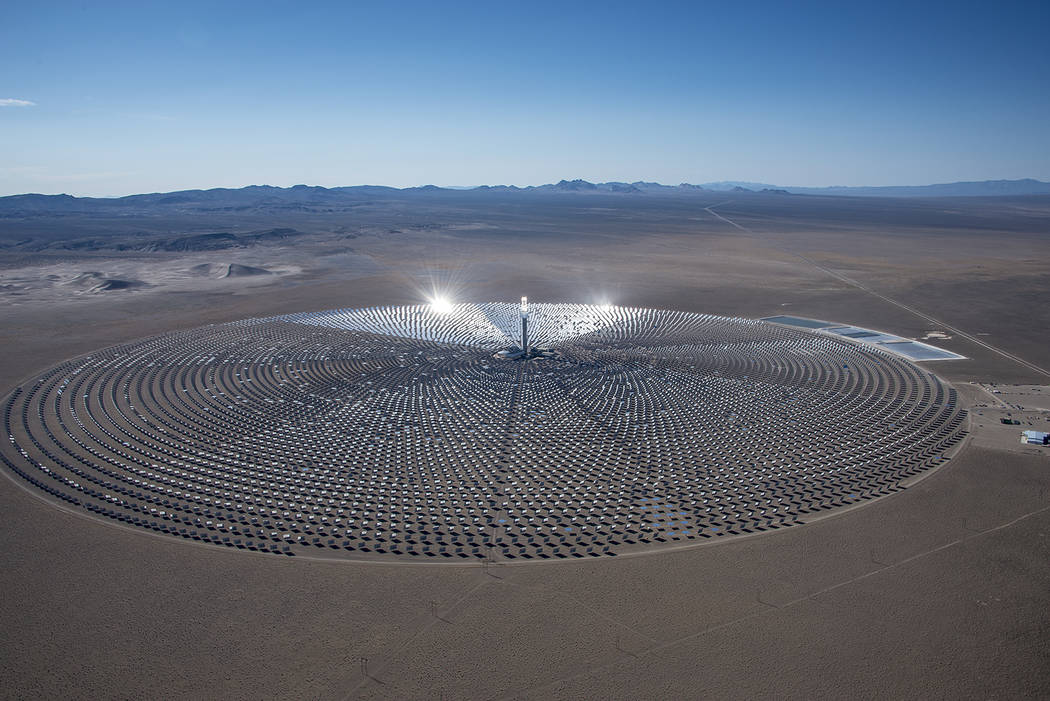
SolarReserve, the parent of the Crescent Dunes Solar Energy Project near Tonopah, is continuing its efforts to replicate its solar thermal technology across the globe.
The Santa Monica-based company is proceeding with its plan to build a 10-tower Project near Tonopah, and other facilities on several continents.
The proposed Sandstone Solar Project would be built on 22,000 acres of U.S. Bureau of Land Management land in Big Smoky Valley.
In August 2017, Sandstone Solar Energy, LLC, a wholly-owned subsidiary of SolarReserve, filed a notice with the Public Utilities Commission of Nevada for eight solar thermal towers for 1,600 megawatts.
Kyle Hendrix, public affairs officer for the BLM Battle Mountain District that covers Tonopah, declined to comment but added that “there’s been a follow-up from the company” as it appears to want to pursue the project.
“At this point, they want to proceed with the idea of analyzing the project,” Hendrix said in a phone conversation.
SolarReserve officials didn’t return requests for comment.
SolarReserve’s projects aim to provide carbon-free, 24/7 energy on the electric grid. The technology that is used by the company is called concentrated solar power and uses hundreds of mirrors to concentrate solar energy and turn it into thermal.
This year, the company will also start development of its second large-scale solar facility, Aurora Solar Energy Project near Port Augusta in South Australia. The project has already received development approval, which is required to build the 150-megawatt solar thermal power station.
The approval process examined a range of elements including environmental, community, and social impacts of the Aurora project, which were assessed by several South Australian government agencies, according to the press release that was put out by SolarReserve.
Development approval is a legal document which enables SolarReserve to construct the Aurora project, provided the construction complies with the submitted plans and any conditions outlined in the development approval, the release said.
SolarReserve has already opened two new offices in South Australia – its headquarters in Adelaide and a field office in Port Augusta to support its new endeavor. With Australia identified “as a priority market for a global organization,” according to SolarReserve, its new team in the country will focus on delivering the Aurora Solar Energy Project and spearhead other projects in Australia.
The company is set to benefit from the declining prices of electricity with concentrated solar power. The memo released by SolarReserve shows that prices for this type of electricity have dropped by more than half since SolarReserve started development of Crescent Dunes in 2009.
The company will get just over six U.S. cents per kilowatt-hour for the power generated by Aurora Solar Energy Project.
SolarReserve’s third plant, the Redstone Solar Thermal Power Project near Postmasburg in South Africa is also moving forward.
In April, the company signed a 20-year power purchase agreement with Eskom, South Africa’s public electric utility company. The 100-megawatt facility, with 12 hours of energy storage, will deliver electricity to more than 200,000 South African homes.
The company also has a pending bid for the Likana Solar Energy Project in the Atacama Desert in Chile, which would sell power for the price of five cents a kilowatt per hour – the lowest price for the output of a CPS project.
The 110-megawatt Crescent Dunes was the world’s first utility-scale concentrated solar power plant to use molten salt towers when it began operating in 2015. Molten salt stores the sun’s heat, allowing the plant to generate electricity 24/7. The company had to shut down the plant in late 2016 after a leak was discovered in the hot salt tank.